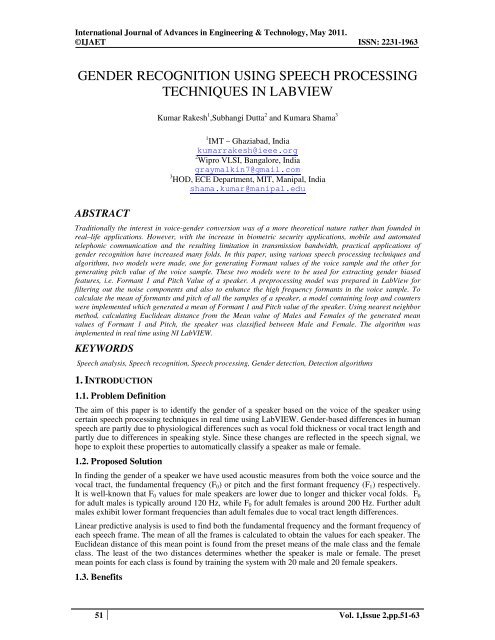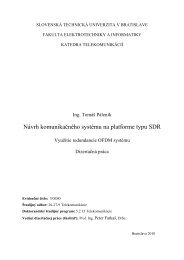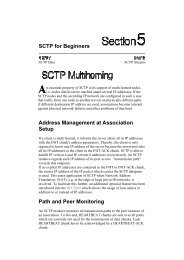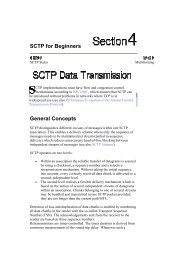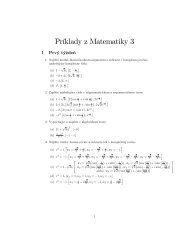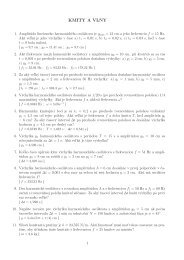gender recognition using speech processing techniques in ... - IJAET
gender recognition using speech processing techniques in ... - IJAET
gender recognition using speech processing techniques in ... - IJAET
You also want an ePaper? Increase the reach of your titles
YUMPU automatically turns print PDFs into web optimized ePapers that Google loves.
International Journal of Advances <strong>in</strong> Eng<strong>in</strong>eer<strong>in</strong>g & Technology, May 2011.©<strong>IJAET</strong> ISSN: 2231-1963Figure 1. Flowchart of Algorithm used for Implementation <strong>in</strong> LabView.4.2. Us<strong>in</strong>g LabVIEW to Detect Formants and PitchSeveral methods can be used to detect formant tracks and pitch contour. The most popular methodhowever is the L<strong>in</strong>ear Prediction Cod<strong>in</strong>g (LPC) method. This method applies an all-pole model tosimulate the vocal tract.Figure 2. Flow chart of formant detection with the LPC methodApply<strong>in</strong>g the w<strong>in</strong>dow w(n) breaks the source signal s(n) <strong>in</strong>to signal blocks x(n). Each signal blockx(n) estimates the coefficients of an all-pole vocal tract model by <strong>us<strong>in</strong>g</strong> the LPC method. Aftercalculat<strong>in</strong>g the discrete Fourier transform (DFT) on the coefficients A(z), the peak detection of 1/A(k)produces the formants.Figure 3.Flow chart of pitch detection with the LPC methodThis method uses <strong>in</strong>verse filter<strong>in</strong>g to separate the excitation signal from the vocal tract and uses thereal cepstrum signal to detect the pitch. The source signal s(n) first goes through a low pass filter(LPF), and then breaks <strong>in</strong>to signal blocks x(n) by apply<strong>in</strong>g a w<strong>in</strong>dow w(n). Each signal block x(n)estimates the coefficients of an all-pole vocal tract model by <strong>us<strong>in</strong>g</strong> the LPC method. These coefficients<strong>in</strong>versely filter x(n). The result<strong>in</strong>g residual signal e(n) passes through a system which calculates thereal cepstrum. F<strong>in</strong>ally, the peaks of the real cepstrum calculate the pitch.56 Vol. 1,Issue 2,pp.51-63
International Journal of Advances <strong>in</strong> Eng<strong>in</strong>eer<strong>in</strong>g & Technology, May 2011.©<strong>IJAET</strong> ISSN: 2231-1963TABLE 3. RESULT OF GENDER DETECTION LABVIEW PROGRAMSample No. Formant 1 Pitch Detection Result1 505.501 160.754 MALE CORRECT2 695.574 176.046 FEMALE CORRECT3 1460.23 173.303 FEMALE CORRECT4 885.016 155.239 MALE CORRECT5 761.23 173.209 FEMALE CORRECT6 714.923 143.659 MALE CORRECT7 522.094 173.754 MALE CORRECT8 679.827 147.77 MALE CORRECT9 784.476 189.635 FEMALE CORRECT10 476.131 143.516 MALE CORRECT11 748.839 190.553 FEMALE CORRECT12 1160.29 181.695 FEMALE CORRECT13 1080.04 147.02 MALE CORRECT14 859.214 179.296 FEMALE CORRECT15 971.238 186.185 FEMALE CORRECT16 1095.92 158.924 MALE CORRECT17 574.057 149.024 MALE CORRECT18 698.892 171.991 FEMALE CORRECT19 709.21 189.829 FEMALE CORRECT20 1310.904 177.549 FEMALE CORRECT21 469.689 139.753 MALE CORRECT22 671.406 179.597 FEMALE CORRECT23 939.004 134.418 MALE CORRECT24 809.216 151.235 MALE CORRECT25 798.291 183.719 FEMALE CORRECT26 749.231 157.821 MALE CORRECT27 914.619 191.605 FEMALE CORRECT28 861.681 178.216 FEMALE CORRECT29 711.191 174.997 FEMALE CORRECT30 910.353 183.512 FEMALE CORRECT31 2150.81 169.182 MALE INCORRECT32 627.236 152.43 MALE CORRECT33 731.902 190.041 FEMALE CORRECT34 829.621 148.051 MALE CORRECT61 Vol. 1,Issue 2,pp.51-63
International Journal of Advances <strong>in</strong> Eng<strong>in</strong>eer<strong>in</strong>g & Technology, May 2011.©<strong>IJAET</strong> ISSN: 2231-19635.2. ConclusionConsider<strong>in</strong>g the efficiency of the results obta<strong>in</strong>ed, it is concluded that the algorithm implemented <strong>in</strong>LabView is work<strong>in</strong>g successfully. S<strong>in</strong>ce the algorithm does not extract the vowels from the <strong>speech</strong>, thevalue obta<strong>in</strong>ed for Formant 1 were not completely correct as they were obta<strong>in</strong>ed by <strong>process<strong>in</strong>g</strong> all thesamples of the <strong>speech</strong>. It was also observed that by <strong>in</strong>creas<strong>in</strong>g the unvoiced part <strong>in</strong> the <strong>speech</strong>, like thesound of ‘s’, the value of pitch <strong>in</strong>creases hamper<strong>in</strong>g the <strong>gender</strong> detection <strong>in</strong> case of Male samples.Likewise by <strong>in</strong>creas<strong>in</strong>g the voiced, like the sound of ‘a’, decreases the value of pitch but the systemtakes care of such dip <strong>in</strong> value and results were not affected by the same. Different <strong>speech</strong> by the samespeaker spoken <strong>in</strong> the near to identical conditions generated the same pitch value establish<strong>in</strong>g thesystem can be used for speaker identification after further work.5.3. Further WorkBy identify<strong>in</strong>g the <strong>gender</strong> and remov<strong>in</strong>g the <strong>gender</strong> specific components, higher compression rates canbe achieved of a <strong>speech</strong> signal, thus enhanc<strong>in</strong>g the <strong>in</strong>formation content to be transmitted and alsosav<strong>in</strong>g the bandwidth. Our work related to <strong>gender</strong> detection showed that the model can successfully beimplemented <strong>in</strong> Speaker Identification, separat<strong>in</strong>g the male and female speaker to reduce thecomputation <strong>in</strong>volved at later stage. Further work is also needed with regard to formant calculation byextract<strong>in</strong>g the vowels from the <strong>speech</strong>. While work<strong>in</strong>g on formants we concluded that <strong>in</strong>clud<strong>in</strong>gformant for <strong>gender</strong> detection would make the system text dependent.REFERENCES[1] Eric Keller, “Fundamentals Of Speech Synthesis And Speech Recognition”.[2] Lawrence Rab<strong>in</strong>er, “Fundamentals of Speech Recognition”.[3] Milan Sigmund. “Gender Dist<strong>in</strong>ction Us<strong>in</strong>g Short Segments Of Speech Signal”.[4] John Arnold. “Accent, Gender, And Speaker Recognition With Products Of Experts”.[5] Florian Metze, Jitendra Ajmera, Roman Englert, Udo Bub; Felix Burkhardt, Joachim Stegmann;Christian M¨Uller; Richard Huber; Bernt Andrassy, Josef G. Bauer, Bernhard Little. “Comparison ofFour Approaches to Age And Gender Recognition For Telephone Applications”.[6] Hui L<strong>in</strong>, Huchuan Lu, Lihe Zhang. “A New Automatic Recognition System Of Gender, Age AndEthnicity”.[7] E. Jung, A. Scwarbacher, R Lawlor. “Implementation of Real Time Pitch Detection For Voice GenderNormalization.”[8] Fan Y<strong>in</strong>gle Yi Li And Tong Q<strong>in</strong>ye. “Speaker Gender Identification Based On Comb<strong>in</strong><strong>in</strong>g L<strong>in</strong>ear AndNonl<strong>in</strong>ear Features”.[9] Eluned S Parris And Michael J Carey. “Language Independent Gender Identification”.[10] W. H. Abdulla & N. K. Kasabov. “Improv<strong>in</strong>g Speech Recognition Performance Through GenderSeparation”.[11] Huang T<strong>in</strong>g Yang Y<strong>in</strong>gchun Wu Zhaohui. “Comb<strong>in</strong><strong>in</strong>g Mfcc And Pitch To Enhance The Performance OfThe Gender Recognition.”[12] Tobias Bocklet1, Andreas Maier, Josef G. Bauer, Felix Burkhardt, Elmar N¨Oth. “Age And GenderRecognition For Telephone Applications Based On Gmm Supervectors And Support Vector Mach<strong>in</strong>es”.[13] D.G.Childers, Ke Wu, K.S.Bae & D.M.Hicks. “Automatic Recognition Of Gender By Voice”.[14] Yen-Liang Shue and Markus Iseli. “The Role Of Voice Source Measures On Automatic GenderClassification”.[15] Deepawale D.S., Bachu R., Barkana B.D. “Energy Estimation Between Adjacent Formant FrequenciesTo Identify Speakers’ Gender”.[16] Yu-M<strong>in</strong> Zeng, Zhen-Yang Wu, Tiago Falk, Wai-Yip Chan. Robust “Gmm Based Gender ClassificationUs<strong>in</strong>g Pitch And Rasta-Plp Parameters Of Speech”.[17] John D. Markel, “Application of a Digital Inverse Filter for Automatic Formant and F o Analysis”.[18] Roy C. Snell and Fausto Mil<strong>in</strong>azzo, “Formant Location From LPC Analysis Data”.[19] Stephanie S. Mccandless, “An Algorithm For Automatic Formant Extraction Us<strong>in</strong>g L<strong>in</strong>ear PredictionSpectra” .[20] John Makhoul,”L<strong>in</strong>ear Prediction: A Tutorial Review”.62 Vol. 1,Issue 2,pp.51-63
International Journal of Advances <strong>in</strong> Eng<strong>in</strong>eer<strong>in</strong>g & Technology, May 2011.©<strong>IJAET</strong> ISSN: 2231-1963[21] Antonio Marcos de Lima Araujo Fiibio Violaro, “Formant Frequency Estimation Us<strong>in</strong>g A Mel Scale LpcAlgorithm”.[22] Ekater<strong>in</strong>a Verteletskaya, Kirill Sakhnov, Boris Šimák, “Pitch detection algorithms and voiced/unvoicedclassification for noisy <strong>speech</strong>”AuthorsMr. Kumar Rakesh received the B.E. degree <strong>in</strong> 2010 <strong>in</strong> Electronics & CommunicationEng<strong>in</strong>eer<strong>in</strong>g from Manipal Institute of Technology. He is presently pursu<strong>in</strong>g MBA <strong>in</strong> F<strong>in</strong>ancefrom Institute of Management Technology, Ghaziabad and would graduate <strong>in</strong> the year 2012. Hehas participated and won several national level events. His research <strong>in</strong>terests <strong>in</strong>clude SignalProcess<strong>in</strong>g, Digital Electronics & Bus<strong>in</strong>ess Valuation.Ms. Subhangi Dutta is work<strong>in</strong>g as a Verification Eng<strong>in</strong>eer <strong>in</strong> the Analog Mixed Signal groupof Wipro Technologies. She completed her B.E. <strong>in</strong> Electronics and Communication fromManipal Institute of Technology, Manipal <strong>in</strong> 2010.Dr.Kumara Shama was born <strong>in</strong> 1965 <strong>in</strong> Mangalore, India. He received the B.E. degree <strong>in</strong>1987 <strong>in</strong> Electronics and Communication Eng<strong>in</strong>eer<strong>in</strong>g and M.Tech. degree <strong>in</strong> 1992 <strong>in</strong> DigitalElectronics and Advanced Communication, both from Mangalore University, India. Heobta<strong>in</strong>ed his Ph. D Degree from Manipal University, Manipal <strong>in</strong> the year 2007 <strong>in</strong> the area ofSpeech Process<strong>in</strong>g. S<strong>in</strong>ce 1987 he has been with Manipal Institute of Technology, ManipalUniversity, Manipal, India, where he is currently a Professor and Head <strong>in</strong> the Department ofElectronics and Communication Eng<strong>in</strong>eer<strong>in</strong>g. His research <strong>in</strong>terests <strong>in</strong>clude Speech Process<strong>in</strong>g,Digital Communication and Digital Signal Process<strong>in</strong>g. He has published many Research papers<strong>in</strong> various journals and conferences.63 Vol. 1,Issue 2,pp.51-63


